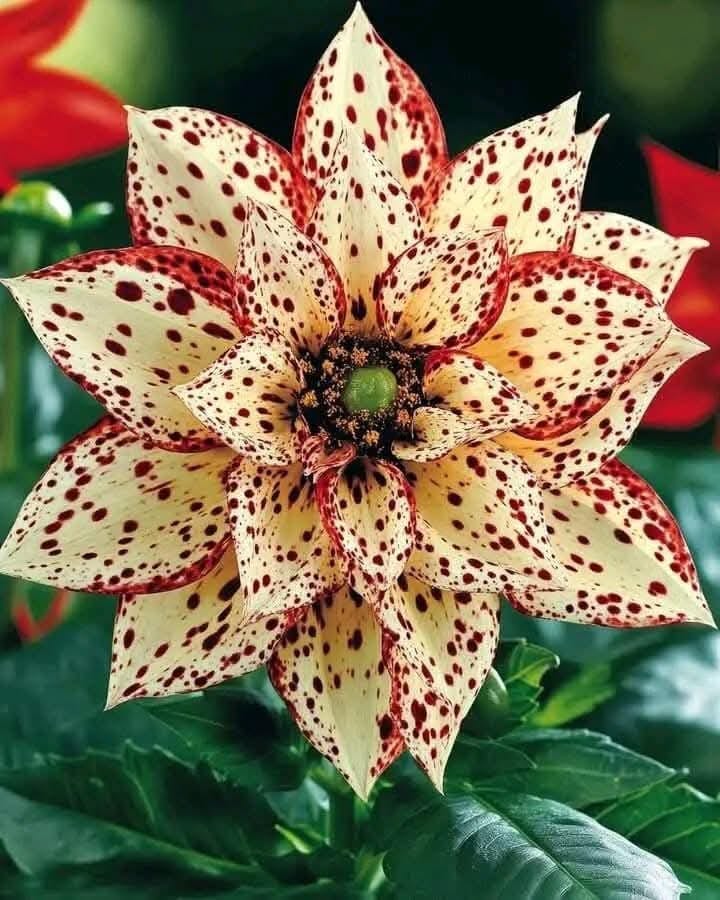The Speckled Dahlia is a standout flower that’s perfect for adding a pop of color and elegance to any garden. Known for its bold, patterned petals, this dahlia variety is celebrated for its unique speckled appearance, combining vibrant shades with delicate markings that resemble splashes of paint. Whether used in borders, floral arrangements, or as a feature plant, the Speckled Dahlia brings charm and beauty to any garden space.
Key Features of the Speckled Dahlia:
- Flower Appearance: The Speckled Dahlia has an eye-catching pattern, with petals that feature contrasting colors and speckled spots. Typically, the petals are a combination of soft cream, white, and vibrant red, but some variations may show different colors. These striking flowers bloom in a round shape and can vary in size, making them perfect for both garden beds and as cut flowers.
- Blooming Season: Dahlia plants bloom throughout the summer and fall, ensuring that your garden remains vibrant for much of the growing season. Their long-lasting blooms make them ideal for extending the color in your landscape.
Growing Conditions for the Speckled Dahlia:
- Light: Dahlias, including the Speckled Dahlia, thrive in full sun. They require a minimum of 6 hours of direct sunlight a day to ensure healthy growth and vibrant blooms. Plant them in a sunny spot where they can bask in the sunlight, especially during the early part of the day.
- Watering: It’s important to keep the soil moist, but not soggy. Overwatering can lead to root rot, so it’s essential to ensure the plant’s drainage is adequate. Water the plant deeply when the soil feels dry to the touch but avoid letting the soil become waterlogged.
- Soil: The Speckled Dahlia prefers well-draining, fertile soil. You can improve drainage by adding organic matter such as compost or peat moss to the soil. A rich, well-draining soil mix encourages strong root development and supports the plant’s growth.
- Temperature: This dahlia variety thrives in moderate climates. It performs best in temperatures between 60°F and 75°F (15°C to 24°C). The Speckled Dahlia is sensitive to frost, so it should be planted after the last frost of the season and brought indoors during cold snaps in winter.
Caring for the Speckled Dahlia:
- Fertilization: Feed your Speckled Dahlia with a balanced fertilizer every 4-6 weeks during the growing season. A balanced fertilizer with equal amounts of nitrogen (N), phosphorus (P), and potassium (K) will support healthy growth and help the plant produce large, colorful blooms. Avoid over-fertilizing, as this can lead to weak growth and fewer flowers.
- Pruning: To encourage continuous blooming, remove spent flowers regularly by cutting them back to the main stem. This is called deadheading, and it helps prevent the plant from going to seed while encouraging the growth of new buds.
- Staking: As the plant grows, it may need support to keep the tall stems upright, especially during windy weather or heavy rain. Use stakes or plant supports to keep the plant from leaning or breaking under the weight of the flowers.
Pest and Disease Management:
While Dahlias are relatively easy to care for, they can occasionally fall victim to pests like aphids, slugs, and snails. To prevent infestations, inspect the plant regularly and remove pests by hand or treat with an organic insecticide like neem oil. Ensure proper air circulation around the plant to reduce the risk of fungal diseases, and avoid overhead watering, which can create a damp environment conducive to mold growth.
Conclusion:
The Speckled Dahlia is a vibrant and stunning addition to any garden. Its bold, patterned petals and long blooming season make it perfect for adding a dramatic and colorful touch to any landscape. Whether used as a cut flower, part of a border planting, or a feature in a flower bed, this plant will add unique flair to your outdoor space. By following the proper care guidelines—full sun, moderate watering, and well-draining soil—you can ensure that your Speckled Dahlia continues to thrive and bloom beautifully season after season.
